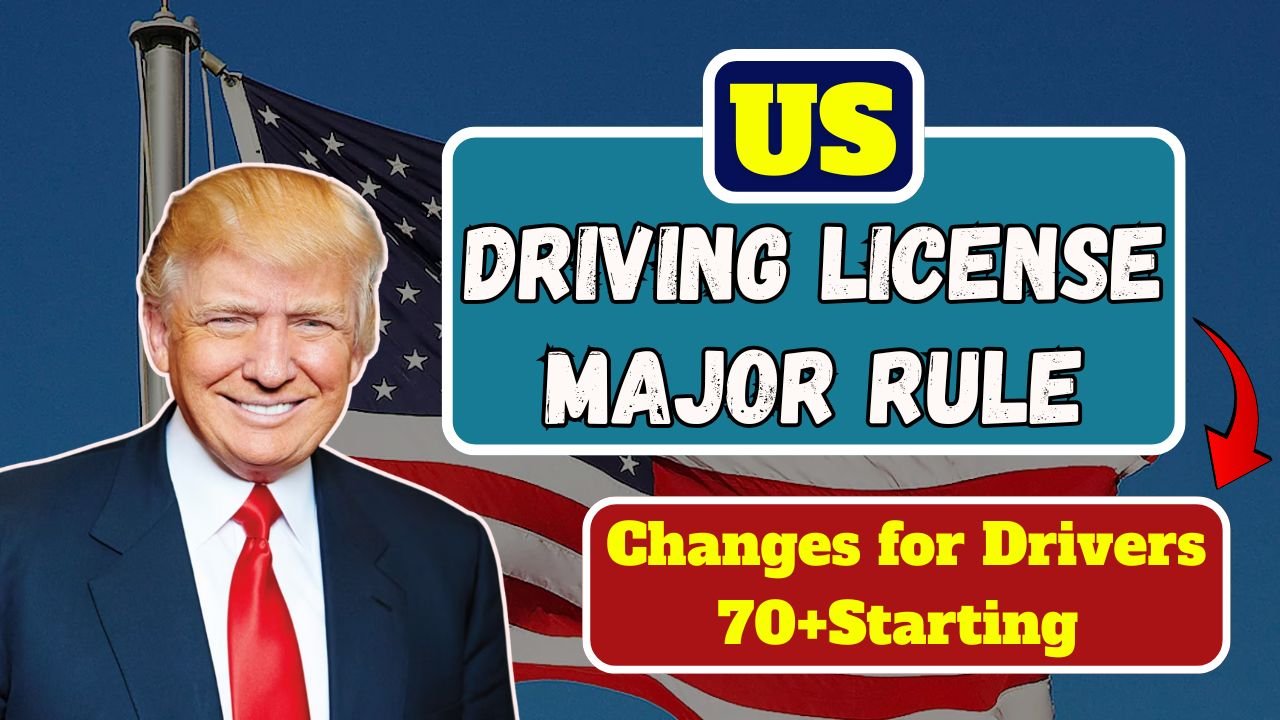US Driving License Major Rule Changes for Drivers 70+: A new national transportation rule will be implemented in the United States starting in October 2025, specifically targeting senior drivers aged 70 and older. This policy, developed by the U.S. Department of Transportation, aims to maintain road safety while ensuring that the independence and self-reliance of older Americans are not compromised. As the senior population continues to grow rapidly, this law is designed to provide a more sensitive and balanced approach tailored to their driving abilities.
Why This Change Was Needed
Currently, there are approximately over 48 million senior citizens (aged 65 and older) who hold driver’s licenses in the United States. This number is expected to increase further in the coming years. Most of these senior citizens rely on a vehicle for their daily needs—whether it’s grocery shopping, doctor’s appointments, or attending social gatherings.
However, natural changes that come with age, such as slower reaction times, poor vision, memory difficulties, and physical frailty, can impact driving ability. This is why the government has decided to renew licenses based on individual abilities, not just age.
This law is not meant to take away anyone’s driving freedom, but rather to ensure that everyone on the road is safe for themselves and others.
Key Features of the New Law
Under this new law, the process for senior citizens’ driving license renewal has been divided into different categories based on age and health. This will be a phased system that will evaluate each driver’s individual abilities.
| Age Group | Renewal Requirement |
|---|---|
| 70–79 years | General renewal, plus vision and reaction tests |
| 80–86 years | In-person renewal required every 2–4 years |
| 87+ years | Road test and medical certificate required every year |
The purpose of this system is to identify any potential problems early and ensure safety, rather than taking away someone’s independence.
Types and Purpose of Tests
Under this policy, drivers may be required to undergo various tests depending on their health and state requirements. These primarily include:
- Vision Test: To check whether a person’s vision is sufficient for safe driving on the road.
- Cognitive Screening: This evaluates memory, reaction time, and decision-making.
- Road Test: This may be mandatory for those over 87 years of age, or if a doctor or family member indicates a potential risk.
The purpose of these tests is to assess the actual state of driving skills so that appropriate decisions can be made.
Can anyone report a senior driver?
Yes, if someone believes a senior is no longer able to drive safely, family members, doctors, or caregivers can report the driver to the DMV (Department of Motor Vehicles). The DMV then re-evaluates the driver’s competence.
However, it is important to note that such reports should be based on genuine safety concerns, not individual differences.
State-Specific Variations
Although this policy will apply nationally, each state may vary its provisions. For example:
| State | Special Needs |
|---|---|
| California | In-person license renewal required after age 70 |
| Florida | Vision test required every time after age 80 |
| Texas | Annual checkup mandatory after age 85 |
| New York | Doctor’s note may be required after age 80 |
These variations are intended to ensure better safety based on local conditions.
Restricted License: A Balanced Solution
It’s not appropriate to completely prohibit every senior from driving. Therefore, the government has offered the option of a Restricted License, which is available to drivers who can safely drive with certain limitations.
These limitations may include:
- Daytime driving only.
- Driving limited to a local area.
- Highway driving restrictions**.
This helps seniors maintain their independence and reduces the risk of potential accidents.
Safe Alternatives to Driving
If a senior is drivingEven if it’s no longer safe to travel, they still have several options to maintain their mobility. These include:
- Ride-sharing services like Uber or Lyft.
- Community shuttle services and paratransit programs designed specifically for seniors.
- Volunteer driver programs, where people provide free transportation.
- Support from family and friends who can pick them up when needed.
These services allow seniors to continue their social interactions and daily routines without risk.
Conclusion
This new transportation law, which will take effect in October 2025, is not designed to take away seniors’ independence, but to protect their safety and dignity.
This policy presents a balanced approach that combines individual assessment, regular testing, restricted licensing, and alternative transportation—all of which provide a safe and humane solution.
The fundamental objective of this law is to ensure seniors maintain their mobility, independence, and self-esteem—while ensuring everyone on the road is safe. This step is not only important for safety, but it will also be a major step toward a more respectful and sensible future for America’s aging population.
FAQs
Q1. When does the new senior driving policy start?
The new national policy for senior drivers begins in October 2025.
Q2. Who will be affected by this law?
All U.S. drivers aged 70 and older will come under the new renewal system.
Q3. Will seniors lose their licenses automatically after a certain age?
No, licenses will not be revoked based on age; renewals depend on individual ability tests.
Q4. What tests will senior drivers have to take?
They may need to complete vision, cognitive, and road tests depending on their age group.
Q5. What if a senior can no longer drive safely?
They can use alternatives like Uber, Lyft, community shuttles, or volunteer driving programs.


